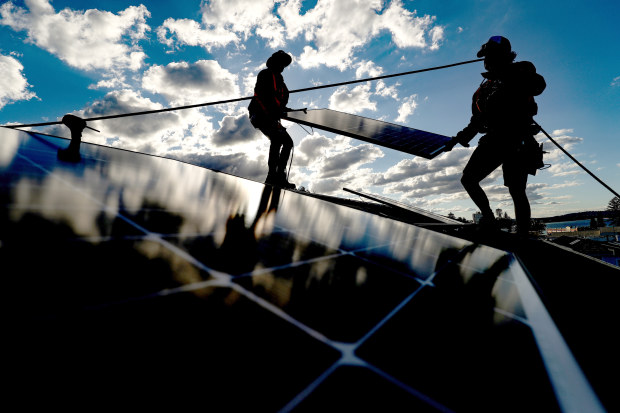Solar boom unleashes surge of below-zero power prices

Plentiful solar power drove wholesale electricity prices below zero a record 19 per cent of the time on the National Electricity Market in the September quarter, piling further economic pressure on ageing coal-fired power plants still needed to meet the bulk of demand.
All regions of the market experienced an increase in negative prices, driving down the daytime average, according to an Australian Energy Market Operator report released on Monday.
Consumers are yet to see any benefit from the dramatic softening in wholesale prices, having been slugged with steep price increases earlier this year.
Electricity default tariffs for households in several states rose by more than 20 per cent on average on July 1, with some customers reporting their bills almost doubled. Whether those tariffs retreat next year hinges partly on wholesale market performance over summer, when AEMO has already warned of potential squeezes as hot El Nino conditions return.
Renewable energy reached almost 39 per cent of total electricity supply in the third quarter of 2023, helping push down average wholesale electricity prices by more than two-thirds.

Rooftop solar output boomed in the September quarter. Bloomberg
The AEMO analysis found multiple records were broken in the power market in the quarter, including reaching a record 11.9 gigawatts of rooftop solar output.
The booming rooftop solar generation helped renewable energy reach a record 70 per cent of total electricity supplied over one half-hour period.
But it also highlights the mounting strain on coal-fired power plants that still supply almost 60 per cent of Australia’s power on average through the year, but which are increasingly undercut in price by cheap wind and solar on the wholesale market.
Plentiful solar power during the day is more frequently sending wholesale prices to zero or lower, forcing coal-fired plants into losses unless they can ramp down capacity.
The conditions help explain the deals being done by state governments in Victoria and NSW with AGL Energy, EnergyAustralia and Origin Energy to underwrite the final years of operation of coal-fired plants so they do not shut before replacement capacity is in place.
AEMO said wind and solar generators were more often bidding their power at negative prices into the wholesale market, reflecting the value of the renewable energy certificates they generate that provide revenue separate from the electricity market.

The 19 per cent of pricing periods that had negative prices was more than double the level of both the June quarter of this year and the September quarter a year earlier. South Australia had the most negative prices, with prices below zero one-quarter of the time. And, when prices went below zero, they fell much more often below -$45 per megawatt hour compared to previous quarters.
“Record renewable generation output helped push down average wholesale electricity prices by more than two-thirds, double the occurrence of zero or negative wholesale prices (19 per cent) and reduce total emissions by 11 per cent compared to the previous September quarter,” AEMO’s executive general manager reform delivery, Violette Mouchaileh, said.
The numerous records set in the market were helped by above-average temperatures across Australia that decreased demand for power from the grid, as a bigger share of demand was met by household solar PV panels. So-called “operational demand”, a figure that calculates demand for power from the grid, hit a new low for the third quarter, of 21,270 megawatts.
Demand on the NEM as a whole also hit a new low, down almost 500 megawatts from the previous minimum at 11,393 megawatts, just after midday on Sunday September 17, AEMO said.
South Australia, Queensland and Victoria all recorded minimum demand records in the quarter, including a low of just 21 megawatts in SA on a Saturday in mid-September when rooftop solar met 98.5 per cent of the state’s underlying electricity demand.
Records have continued to fall this month, with AEMO reporting on Friday a new high for renewable energy penetration in the NEM of 71.3 per cent, in a 30-minute period up to midday. Rooftop solar met more than 44 per cent of total electricity generated at the time.
Wholesale prices fell sharply from the elevated levels of 2022, with the average across the NEM down 71 per cent from the September quarter last year to just $63 a megawatt hour.
SA had the highest average price, of $92 megawatt hours, and Tasmania the lowest at $29 megawatt hours.
The numbers reflect the trends reported by the Australian Energy Regulator last week, which said electricity demand fell to a record low for the September quarter, down 5 per cent, while rooftop solar output surged 31 per cent.
Introducing your Newsfeed
Follow the topics, people and companies that matter to you.
Find out moreRead More
Latest In Energy
Fetching latest articles